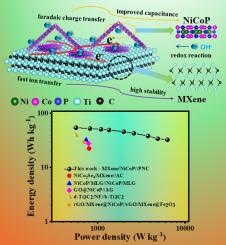High-performance asymmetric supercapacitors based on 2D MXene/NiCoP hybrid and ZIF derived porous nanocarbon
IF 14.3
1区 材料科学
Q1 MATERIALS SCIENCE, MULTIDISCIPLINARY
引用次数: 0
Abstract
The performance of supercapacitors can be improved by strategically designing 2D MXene-based electrodes with excellent electrochemical properties. However, several challenges remain in developing hybrid materials based on 2D MXenes due to restacking, which hinders energy storage performance. In this work, we successfully synthesized a 2D MXene/Ni-Co phosphide (MX/NCP) hybrid material for supercapacitors via a facile hydrothermal reaction followed by phosphorization. The optimized MX/NCP positive electrode showed good energy storage performance with a specific capacitance of 1754.0 F g−1 at 3 mA cm−2 in a three-electrode configuration. The synergistic effect of MXene and Ni-Co phosphide has contributed towards the enhanced charge storage performance. Furthermore, an asymmetric supercapacitor (ASC) fabricated with MX/NCP and porous nanocarbon (PNC) delivered a maximum energy density of 54.3 Wh kg−1 at a power density of 565.6 W kg−1 with a cycling stability of 93.8% after 10000 cycles. To evaluate the practical versatility of the ASC, a planar device was successfully fabricated making MX/NCP a promising electrode material in next-generation wearable and flexible supercapacitors.

基于二维MXene/NiCoP杂化和ZIF衍生多孔纳米碳的高性能非对称超级电容器
通过战略性地设计具有优异电化学性能的二维mxene电极,可以提高超级电容器的性能。然而,在开发基于2D MXenes的混合材料方面仍然存在一些挑战,因为重新堆叠会阻碍能量存储性能。在这项工作中,我们成功地通过简单的水热反应和磷酸化合成了用于超级电容器的二维MXene/Ni-Co磷化物(MX/NCP)杂化材料。优化后的MX/NCP正极在3 mA cm−2时的比电容为1754.0 F g−1,具有良好的储能性能。MXene和Ni-Co磷化物的协同作用有助于增强电荷存储性能。此外,用MX/NCP和多孔纳米碳(PNC)制备的非对称超级电容器(ASC)在功率密度为565.6 W kg - 1时,最大能量密度为54.3 Wh kg - 1,循环10000次后的循环稳定性为93.8%。为了评估ASC的实际通用性,成功制造了一个平面器件,使MX/NCP成为下一代可穿戴和柔性超级电容器中有前途的电极材料。
本文章由计算机程序翻译,如有差异,请以英文原文为准。
求助全文
约1分钟内获得全文
求助全文
来源期刊

Journal of Materials Science & Technology
工程技术-材料科学:综合
CiteScore
20.00
自引率
11.00%
发文量
995
审稿时长
13 days
期刊介绍:
Journal of Materials Science & Technology strives to promote global collaboration in the field of materials science and technology. It primarily publishes original research papers, invited review articles, letters, research notes, and summaries of scientific achievements. The journal covers a wide range of materials science and technology topics, including metallic materials, inorganic nonmetallic materials, and composite materials.
 求助内容:
求助内容: 应助结果提醒方式:
应助结果提醒方式:


